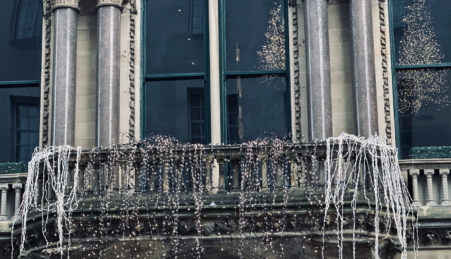With the US in the midst of a tumultuous change of office, and having just finished a lengthy election process, many of you may be wondering just how the US elections really work. What is the deal with the electoral college? And Jeez! Why did this whole process take so long!? Even for me, a genuine American, the process is confusing, convoluted, and frustrating (especially this year!). So I’ve decided to give you the down-low on the whole process. Bear with me, because we’ve got a lot going on across the pond.
First, in order to understand the election process in the United States, it’s important to learn the lingo.
When the constitution was originally written, the founding fathers decided that power must be separated in order to ensure that no individual or group could hold too much power. In order to ensure this, they created three distinct branches of the government.
Executive Branch
The executive branch includes the President of the United States, the Vice President, and the Cabinet. I’m sure you are all fairly familiar with what these jobs entail, but in the spirit of sharing, it is the Executive Branch that carries out and enforces the laws that are created by Congress. The President of the United States acts as head of state, the leader of the federal government, and Commander in Chief to the US Armed Forces. If the president is unable, for any reason, to serve as they are meant to, it is the Vice President’s role to step in and serve in their place. They are there to support the president. Each president serves a term of four years and can be elected no more than twice, while the Vice President can serve an unlimited number of four-year terms, even if they are serving under a different president.
The Cabinet is made up of the Vice President as well as the heads of executive departments. All Cabinet members are nominated by the president and are approved by a majority Senate vote of at least 51 of the 100 members of Senate in office. The job of the various members of the Cabinet is to guide and advise the President of the United States.
Legislative Branch
The Legislative Branch is mainly Congress, with a few other governmental offices and agencies sprinkled in. Congress is made up of the Senate and the House of Representatives. This group drafts bills and proposals, they are effectively in charge of making the laws. They also have the power to confirm or reject the President’s nominees for heads of department, declare war, and even vote the President out of office in special circumstances.
Every member of Congress is voted into office by the public. The Senate is made up of 100 elected individuals, two per state. They serve a term of 6 years, and there is no limit to the number of terms they can serve. The House of Representatives is a little bit trickier. In total there are 435 elected Representatives. Each state has a different number of Representatives determined by its population. So while California has 53 elected Representatives, Washington State only has 10. A Representative’s term lasts only two years, but again, there is no limit to the number of terms they can serve.
Judicial Branch
The Judicial Branch of the United States Government includes the supreme court and the federal courts. It is the Supreme Courts’ job to interpret the laws, decide if laws are in violation of the United States Constitution, and apply the law to specific court cases. All nine members of the Supreme Court are nominated by the president and must be approved by the Senate. In recent cases, like with the death of Justice Ruth Bader Ginsburg, there are competing interests in choosing a replacement so close to the election, especially because Supreme Court Judicial members serve a life-long term. If particularly conservative or liberal members of the Supreme Court are nominated and approved, the balance in the Supreme Court could shift drastically in one direction, which can have a decades-long impact. Luckily, the process of filling that empty seat can take, on average, 67 days.
On to the Election
I know, I know, it’s a lot to process. But in order to understand the election itself, it’s beneficial to understand just how the government really works, because the presidential election is not just a process of electing a new president, but a process of electing other government officials, Representatives, and Congressmen too, whether they have the experience or not. In fact, in my home state of Washington, the infamous Goodspaceguy has run for public office 21 times, for local, state, and federal positions. In this year’s primary election he ran for Governor of Washington. There is a lot to determine besides just who will become the next President of the United States.
Primaries and Caucuses
As far back as 2017, President Trump announced his decision to run for a second term. This is not unusual, in fact, from that point forward, well into May of 2019, a line up of other well-known, and not so well-known, figures threw their names into the bid for presidential candidacy. Each of these people had their own views on how the government should be run. They ranged from the far far left, to ultra-conservative, declared their position as Democrat, Republican, Independent, and even Green Party, but by and large, the majority safely announced their bid for one of the two main parties, Democrat or Republican.
From this point forward candidates for the presidency travel the country giving speeches, demonstrations, and debates, attempting to sway the general public, specifically members of their own party, to support them in their candidacy. In August of 2020, primary elections and caucuses were held to determine who would become the designated candidate of each party.
There are two very different ways in which states cast their votes to nominate their presidential candidate, either through a caucus or a primary vote. Most states hold either an open or closed primary election. In a closed primary, registered members of each party (most voters have registered to vote under a specific party) may only cast their votes for a member of their own party. In an open primary voters can choose to vote for whomever they choose regardless of party. This is simply done through a ballot box, or by mail.
There are, however, four states which use a caucus as their primary way of choosing a presidential candidate, and one state (*cough *cough Kentucky) in which only the republican party uses a caucus, while the Democratic party has a primary. In addition, there are some US territories that also use a caucus. During a caucus, voters are chosen to represent and persuade the public to their chosen candidate’s cause. These are usually voters who are particularly politically engaged. After a series of discussions and votes, a member is eventually chosen to represent the party.
The National Convention
After the votes have been cast, it is time for each party to designate its official nominee. This is when the National Convention takes place. This year there was some controversy surrounding the Republican National Convention as President Trump decided to hold a live event, while nominee Biden hosted his event online. It is during the National Convention that each presidential candidate also announces their choice of Vice President.
General Election
Finally, the general election. This is what we are in the midst of right now. The general election takes place on the Tuesday following the first Monday in November. During the general election the public casts their votes on who they think the next president should be, they also vote on new Representatives, members of Senate, and other elected officials. The tricky thing here is that when voters cast their ballot, they don’t really have a personal say in who becomes president. In reality, they are trying to sway the vote of the electoral college.
The Electoral College
Arguably, the Electoral College is the most confusing aspect of the United States elections. In reality, it is meant to not only simplify the voting process but, also to put all states on equal footing when voting. Since America is made up of states like California with a population of over 39 million, and Wyoming with only 580,000, you can imagine that if the general public were to decide the president, it would mainly be California, Texas, and Florida who would be making that decision. That’s where the Electoral College comes into play. Similar to how each state has a certain number of Representatives, based on its population, the same is true of the Electoral College. The Electoral College is a separate group of individuals whose sole responsibility is to choose the president. There are 538 electors, equivalent to the number of Representatives, 435, Senators, 100, plus 3 additional votes from Washington D.C. (remember it’s the U.S. capitol, not a state). The Electoral College is made up of real people, and these are the people that the general public is really casting their ballots for during the election. When a majority vote is cast in a particular state, that state then sends a slate of electors to cast their own votes. It is expected that these electors will honor the vote of the public, by casting their own vote for whoever the majority of voters chose. Generally, states award all of their electoral votes to whoever wins the poll. However, there are two states, Maine and Nebraska, which divide up their electoral votes depending on the proportions of the vote each candidate received. It’s because of the Electoral College, that presidential candidates focus much of their energy on “swing states”, those states that have a large number of electoral votes, and could lean towards either party. The first candidate to win the majority of Electoral votes, 270, becomes the next president.
Although most electors stay true to the public’s vote, neither the Constitution nor federal law requires them to cast their votes in line with the popular vote of their state. Electors who break with the general public’s vote, are referred to as “faithless electors”. In 2016, seven electors voted in opposition to the public on the presidential ballot. Because of this, many states have passed their own laws to punish “faithless electors”.
So why did it take so long this time?
Believe it or not, this year’s general election actually moved fairly quickly. In the election of 1800, for example, due to a ‘contingent election’, in which both candidates tie and the vote then moves to the House of Representatives, a president was not chosen until February of 1801! More recently, the 2000 election between George W. Bush and Al Gore took 35 days after a Supreme Court decision to halt the Florida recount. In the case of our current election, the delay was due, in part, to a large number of mail-in ballots, and differing regulations in each state. Some states allow votes to be counted and tallied before election day, while some require counting to wait until election day. Differing deadlines for mail-in ballots also causes problems. With this year’s election falling amidst the confusion and chaos of the COVID-19 pandemic, it is also important to note that a record number of mail-in ballots were utilized by voters. These take longer to be counted and verified. All we can hope for is honesty, integrity, and patience on the parts of both presidential candidates, and the general public during these times. With Biden’s recent win, let’s hope the change of office goes smoothly as well.
So there you have it. A rough overview of the election process as told by your very own expat. Make sure to keep an eye on the news over the next few weeks. I’m sure the switch from Trump to Biden will be something to see.





Leave a reply